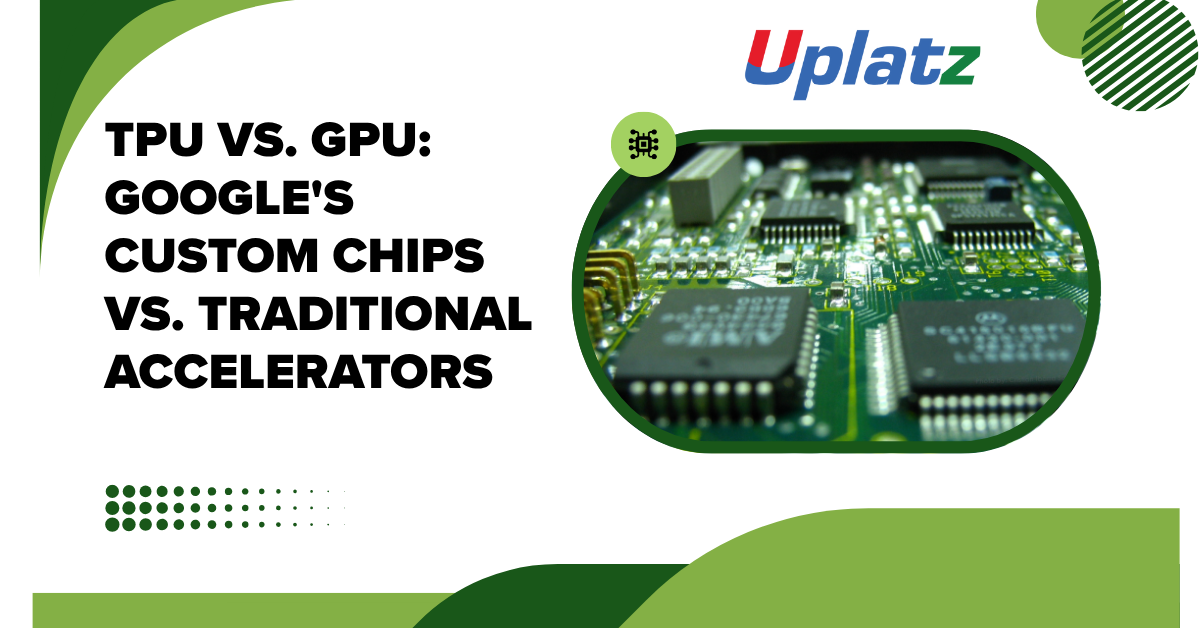TPU vs. GPU: Google’s Custom Chips vs. Traditional Accelerators
Modern machine learning workloads demand high computational throughput and energy efficiency. Google’s Tensor Processing Units (TPUs) and traditional Graphics Processing Units (GPUs) represent two distinct hardware approaches: TPUs are application-specific integrated circuits (ASICs) optimized for tensor operations, while GPUs are general-purpose parallel processors supporting a broad range of compute tasks. This report compares their architectures, performance characteristics, programming models, and ideal use cases.

- Architectural Overview
1.1 TPU Architecture
TPUs leverage a systolic array design specialized for matrix multiplications. Each TPU v3 chip contains two TensorCores, each with two 128×128 matrix-multiply units (MXUs), vector units, and scalar units. TPUs use high-bandwidth memory (HBM2) to feed the MXUs, minimizing off-chip memory access during computation. TPU v4 advances this by offering two TensorCores per chip, with four MXUs each and HBM2 capacity of 32 GiB at 1200 GB/s, interconnected in 3D mesh networks for pod deployment.
1.2 GPU Architecture
GPUs such as NVIDIA’s A100 are built on the Ampere architecture, comprising multiple Streaming Multiprocessors (SMs). Each SM contains 64 FP32 CUDA cores and 4 third-generation Tensor Cores capable of 256 FP16/FP32 fused-multiply-add (FMA) operations per clock. An A100 GPU has up to 108 SMs, HBM2e memory (40 GB at 1555 GB/s), and supports NVLink and PCIe Gen4 interconnects for multi-GPU scaling.
- Performance Comparison
| Metric | TPU v3 (per chip) | TPU v4 (per chip) | NVIDIA A100 (per GPU) |
| Peak Compute | 123 TFLOPS (bfloat16) | 275 TFLOPS (bfloat16/int8) | 19.5 TFLOPS (FP32) |
| High-Bandwidth Memory | 32 GiB @ 900 GB/s | 32 GiB @ 1200 GB/s | 40 GB @ 1555 GB/s |
| Tensor Cores | 4 MXUs per chip | 8 MXUs per chip | 432 third-gen Tensor Cores |
| Power Consumption (mean) | 220 W | 170 W | 250 W (PCIe) / 400 W (SXM) |
| Interconnect Topology | 2D torus (v3 pods) | 3D mesh/torus (v4 pods) | NVLink 3.0 / PCIe Gen4 |
| Pod Scale | 1024 chips (126 PFLOPS) | 4096 chips (1.1 EFLOPS) | Multi-GPU clusters via NVLink |
TPUs excel in dense tensor operations and scale linearly in pod configurations, achieving up to 1.1 exaflops in TPU v4 pods. The A100 offers versatile precision support (FP64, TF32, FP16, BF16, INT8) and excels in mixed workloads, with up to 624 TFLOPS FP16 performance when exploiting structured sparsity.
- Programming Models
3.1 TPU Programming
TPU programming centers on TensorFlow or JAX with XLA compilation. Models are compiled into HLO (High Level Optimizer) graphs, which XLA lowers to TPU executables. TPU pods use synchronous data parallelism via infeed queues and collective operations for all-reduce across cores. Careful batch sizing divisible by core count ensures high utilization.
3.2 GPU Programming
GPUs follow a heterogeneous model with CUDA or ROCm. Developers write kernels executed on device SMs, organized into grids of thread blocks. Memory management (global, shared, constant) and explicit data transfers (e.g., cudaMemcpy) between host and device are key considerations. Libraries such as cuDNN and cuBLAS abstract low-level details for deep learning workloads.
- Cost and Energy Efficiency
- TPUs provide superior performance-per-watt for large-scale neural network training and inference, with up to 80× higher TOPS/Watt than contemporary GPUs in inference tasks.
- GPUs offer more flexibility across diverse tasks, but at higher energy cost per tensor operation. Multi-instance GPU (MIG) on A100 allows partitioning resources for lower-latency inference workloads.
- Use Cases and Suitability
- Ideal for TPUs
- Large-scale training and inference on Google Cloud.
- Models with heavy matrix multiplication (e.g., Transformers, CNNs).
- Workloads benefiting from TPU pod scaling to petascale or exascale compute.
- Ideal for GPUs
- Mixed-precision training, HPC simulations, graphics workloads.
- On-premises deployments with existing CUDA ecosystem.
- Research requiring experimentation in diverse frameworks and precision formats.
- Conclusion
TPUs and GPUs represent complementary accelerator paradigms. TPUs deliver unmatched efficiency for tensor-centric ML workloads at massive scale, particularly within Google’s infrastructure. GPUs provide broader applicability, richer precision support, and flexible development ecosystems. Selecting between them depends on workload characteristics, scale requirements, and infrastructure preferences.
